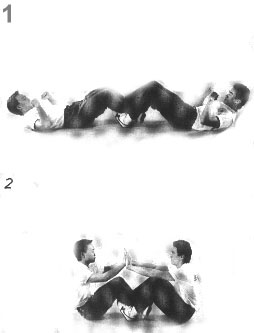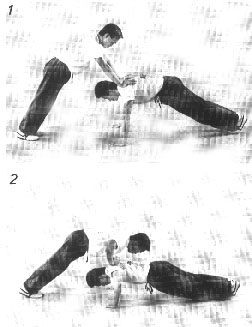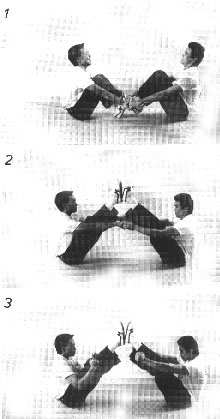

Probably the most dreaded aspect of martial art training is streching and muscle toning, and strengthening exercises. However, Hwa Rang Do - the Korean martial and healing art, has developed several training alternatives involving partners - two men, two women or a man and woman - which can make working out more enjoyable and productive.
One of the most efective training methods is working out with a partner. The "buddy system" works incredibly well in all fields of endeavor, whether it be professional, educational or social. Training with partner can mean the difference between success and failure; it can push you to limits far beyond your wildest dreams or it can make you dread and loathe any form of physical workout.
In Hwa Rang Do, there is great emphasis placed on working with a partner. There are advantages to working with a compatible colleague rather than training alone. Once again, the key is to find a good partner who is willing to sacrifice a little to gain a lot for both parties.
Choosing a partner
There are three points to remember when choosing a training partner:
Similar interest - Although this is not the most crucial
point, it is important for establishing a long-term working relationship; having
the same interests will create more opportunities for the partners to spend
time together which, in turn, allows for more training time. Also, you will
gain a valuable friend in the process. 
Similar body type and size - It is important to choose a partner who has a similar physique. If there is a large difference in weight or height, for example, it will be more difficult to accomplish your goals. A large person will be too heavy or strong in the exercises which require him to use his boyd weight as a form of resistance.
The um-yang theory - In the Oriental philosophy of metaphysics of um-yang, nature is embodied by two polar dichotomies which coexist to maintain a harmonious balance within the universe. In other words, it is necessary opposites or unlike things exist. If we were to apply this to our training, then opposite personalities would attract. However, this is contradictory to what we've just said. But in this case we are discussing personalities rather than physique. The body types should be similar, but their motivational level, energy level and emotional intensities must differ. For example, a calm, quiet man matched against another calm, quiet man with low energy levels will bring about low results. One person must push the other when needed, and one must calm the other if the energy level is too high. Easily excitable people will have a tendency to push too hard, which results in injury and defeats the initial purpose.
Although outwardly complicated, this in-depth search for a partner only is recommended for people who are interested in having a long-term relationship. One classic example in Michael Echanis, the first American to be taught by Hwa Rang Do Supreme Grandmaster Dr. Joo Bang Lee in the secret techniques of un shin bop (art of being unseen) and given the title of a Sulsa. Echanis and close friend and training partner Chuck Sanders developed almost a symbiotic relationhip, which proved to be most effective in advancing their hand-to-hand combat skills for the U.S. military.
If a long-term relationship is not important, then the training and stretching exercises can be performed with almost anyone.
Two-man benefit
The benefits of training with a partner are far greater than training alone:
Motivational factor - A lack of motivation is one of the biggest reasons
of disgressing or quitting training. If you have an enthusiastic partner, this
problem is immediately solved. With a person in front of you, cheering you on
to do one more, jump an inch higher, or push a little harder, the workouts will
help you realize and overcome your limitations. 
Multitude of exercises - With two people, the number of exercises one can do increases almost 100 percent. This will prevent the "burn-out syndrome" from happening thanks to the addition and variety of exercises.
Intensity of training - Training intensity is important for producing outstanding results. Instead of doing normal push-ups, now it becomes two or three times more intense with the other person assisting and placing the right amount of resistance in each of the exercises. When the intensity level increases, so do the results.
Positive criticism - Often we unaware of the little mistakes we make in our training. A partner with proper knowledge will point out the mistakes in detail, giving his partner a chance to realize and correct his mistakes.
Positive reinforcement - Along the same lines as "positive criticism," a patient partner will act as an incentive in pushing his friend to new hights.
Gauge of progress - Having your partner observe your performance and do the same exercises will help you determine your progress. Also, the "positive criticism" given from your partner is a good way to measure your progress.
Spirit of competition - In Business, competition is the key to innovation. Humans are by nature competitive, and by working with a partner of a similar skill level, you can achieve remarkable things, while cultivating the competitive spirit for future victories.
Fun - Last, but not least, working with a partner is fun. Man has gone to great extremes to have fun and having fun brings happiness. Therefore, a training session with lots of fun will never end and the participants will never quit.
Two-person exercises
After understanding why you might train with a partner, the next step is
knowing what exercises to practice. Before you embark on any form of physical
training, you must learn how to correctly warm up. This will prevent injuries
which could impede progress. One great way of warming up is tande jump roping
or just jumping or jogging in place as you shadowbox. Also, warming up on a
bag can be fun and effective. After warming up for about five-to-ten minutes,
you and your partner are ready to start the stretching exercises. The hamstrings,
groin muscles, Achilles tendon, thigh muscles, and hip muscles are areas that
need stretching prior to a martial arts workout. There are several points to
remember:
Keep steady pressure - Do not make jerky movements while
stretching. It could lead to pulled or torn muscles. 
One-minute and two-rep minimum - Stretch each muscle for at least one minute and two repititions. Stretch a particular muscle with which you have difficulty for longer periods, but no longer than 30 minutes. This can be done while watching television or reading a book.
Pain factor - Some suggest unless you feel pain, the muscles are not being stretched. On the other hand, some exercise physiologists maintain pain does not determine the effectiveness of the stretch and you should not stretch to where it causes pain. There is some truth to both: You should stretch to where you feel slight discomfort and hold that position. However, you should not inflict self-torture.
Persistence - Most great men have received their fame neither from raw talent nor pure genius, but from their persistence. They go on when everyone else quits. When traveling the road to flexibility, you need the same traits. You must keep going if you want to get somewhere. Stretching with a partner can be fun, but you must be careful not to overdo it and risk injury.
In toning the muscles, there is no substitute for hard work; another person can push and pull you to success. Accompanying this article are some great exercises for developing and strengthening the arms, legs, hips, shoulders, chest, and especially the stomach, which is hard to maintain. The muscle-strengthening and toning exercises require lots of push and energy to be beneficial. Three repitions of ten counts each should be ideal. With each count the partner increases his resistance for greater results.
Breathing is the most important aspect of any form of physical training. Learn to breathe; it could someday save your life. You would be surprised at how many people actually work out as though they were underwater. Breathing is vital to your performance. In the air is an invisible energy called ki (the Chinese call this chi) and it gives life to all things. If one can control breathing, one can control the rate of his progress. Remember: Breathe slowly, deep and exhale slowly, far.
After a strenuous workout, the body needs to be replenished and rested. Some of the most effective ointments for muscle aches are "Tiger Balm," "Zeng Gu Shui," and "White Flower Ointment." These three are effective, 100 percent natural and work best when they are accompanied by a slow, gentle rubbing massage.
These are some of the training tips and methods we practice in Hwa Rang Do. Although they have been proven effective, they are by no means the only viable exercises. Experiment with your partner and see what works best. You'll quickly discover two heads and bodies are better than one.